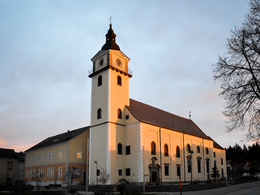Windhaag Church
Windhaag bei Perg, Oberösterreich, Österreich
The portal leads into a two-bay vestibule, from which one door each leads into the chime house, the lower cloister and the church interior. This is a clearly laid out hall church. It has a single nave and six bays. The light enters the room from the south through two rows of windows arranged one above the other.
The gallery in the west rests on four slender granite pillars and served as a choir room for the nuns during the monastery period.
Compared to the nave, the chancel in the east is lower and indented to the side. It has three bays and a straight chancel end. The two high altarpieces are the work of Johann Wolfgang Dallinger from around 1690 and depict scenes from the life of the church's patron saint. The main painting, which shows the Assumption of the saint into heaven, was partially painted over in the last century. When the interior of the church was renovated in 1984, the restorer Friedrich Fuchs restored it to its original form. The high altar tabernacle dates back to 1913 and is the work of the Braunau artist Georg Wagner. The old high altar tabernacle was fitted into the left side altar after a previous restoration. A fine baroque sculpture of St Florian stands in a niche on the north wall of the chancel. It was donated by a charitable nun in 1738.
Interior view of the parish churchThe left side altar is dedicated to St Dominic, who is depicted in the main picture with the Mother of God. The upper picture shows the presentation of the rosary to the saint. The figures of saints from the Dominican order flanking the altar cannot be identified. The final figure of St Michael should be emphasised as a good sculpture. A late Gothic statue of the Madonna is of excellent quality. After being painted over in the 19th century, a renovation in 1979 restored it to its original form.
The folds, the facial expression and the angels at Mary's feet reveal an early work by Hans Leinberger from around 1510.
The sculpture is probably the only remaining remnant from the art treasures of the former Windhaag castle chapel, which Anna Prager had redecorated at the beginning of the 16th century.
The right side altar is dedicated to St Agnes of Monte Policiano. The main and upper picture show similar motifs, namely the depiction of the saint with the Mother of God. Of the figures, a guardian angel as the final figure and the depiction of a Man of Sorrows under a canopy-like exposition throne, which was a gift from Maria Theresa to the nuns of Windhaag and features embroidery by the empress herself on the inside, are worth mentioning.
On the north wall of the nave are the pulpit and the depiction of Our Lady of Sorrows from the first half of the 18th century. On the left-hand side of the nave, under the gallery, is a beautiful Christmas altar, formerly also known as the baptismal altar. The altarpiece, which depicts the birth of Christ, is flanked by statues of St Mary Magdalene (left) and St Catherine (right). The final figure of Mary with the Child is also worthy of note. All of these sculptures date from around 1700 and burials took place in the former monastery church between 1706 and 1738. Those buried were mainly of clerical rank: Father Ambrosius Glöckl, a native of Graz, confessor and preacher in the monastery, died on 9 March 1706 and is commemorated by the inscription on the south wall of the church below the gallery, which was discovered when the church was painted in 1984. Father Ambrosius Seidl, confessor at the monastery for 18 years, died on 30 March 1733 and his tombstone is still preserved in the church.
The apostles' crosses painted on the south and north walls were discovered and refreshed in 1984 when the church was repainted. An upper and lower cloister adjoins the north side of the nave. It was structurally united with the church after the abolition of the monastery so that the nuns' crypt in the lower cloister would not have to be profaned. The crypt itself is empty. An altar made of granite stones was erected there in 1931 and covered with a stone slab. The bones of the buried nuns were laid in the cavity created. According to the register of the dead, 75 Dominican nuns died in the period from 1676 to 1830.
The gallery in the west rests on four slender granite pillars and served as a choir room for the nuns during the monastery period.
Compared to the nave, the chancel in the east is lower and indented to the side. It has three bays and a straight chancel end. The two high altarpieces are the work of Johann Wolfgang Dallinger from around 1690 and depict scenes from the life of the church's patron saint. The main painting, which shows the Assumption of the saint into heaven, was partially painted over in the last century. When the interior of the church was renovated in 1984, the restorer Friedrich Fuchs restored it to its original form. The high altar tabernacle dates back to 1913 and is the work of the Braunau artist Georg Wagner. The old high altar tabernacle was fitted into the left side altar after a previous restoration. A fine baroque sculpture of St Florian stands in a niche on the north wall of the chancel. It was donated by a charitable nun in 1738.
Interior view of the parish churchThe left side altar is dedicated to St Dominic, who is depicted in the main picture with the Mother of God. The upper picture shows the presentation of the rosary to the saint. The figures of saints from the Dominican order flanking the altar cannot be identified. The final figure of St Michael should be emphasised as a good sculpture. A late Gothic statue of the Madonna is of excellent quality. After being painted over in the 19th century, a renovation in 1979 restored it to its original form.
The folds, the facial expression and the angels at Mary's feet reveal an early work by Hans Leinberger from around 1510.
The sculpture is probably the only remaining remnant from the art treasures of the former Windhaag castle chapel, which Anna Prager had redecorated at the beginning of the 16th century.
The right side altar is dedicated to St Agnes of Monte Policiano. The main and upper picture show similar motifs, namely the depiction of the saint with the Mother of God. Of the figures, a guardian angel as the final figure and the depiction of a Man of Sorrows under a canopy-like exposition throne, which was a gift from Maria Theresa to the nuns of Windhaag and features embroidery by the empress herself on the inside, are worth mentioning.
On the north wall of the nave are the pulpit and the depiction of Our Lady of Sorrows from the first half of the 18th century. On the left-hand side of the nave, under the gallery, is a beautiful Christmas altar, formerly also known as the baptismal altar. The altarpiece, which depicts the birth of Christ, is flanked by statues of St Mary Magdalene (left) and St Catherine (right). The final figure of Mary with the Child is also worthy of note. All of these sculptures date from around 1700 and burials took place in the former monastery church between 1706 and 1738. Those buried were mainly of clerical rank: Father Ambrosius Glöckl, a native of Graz, confessor and preacher in the monastery, died on 9 March 1706 and is commemorated by the inscription on the south wall of the church below the gallery, which was discovered when the church was painted in 1984. Father Ambrosius Seidl, confessor at the monastery for 18 years, died on 30 March 1733 and his tombstone is still preserved in the church.
The apostles' crosses painted on the south and north walls were discovered and refreshed in 1984 when the church was repainted. An upper and lower cloister adjoins the north side of the nave. It was structurally united with the church after the abolition of the monastery so that the nuns' crypt in the lower cloister would not have to be profaned. The crypt itself is empty. An altar made of granite stones was erected there in 1931 and covered with a stone slab. The bones of the buried nuns were laid in the cavity created. According to the register of the dead, 75 Dominican nuns died in the period from 1676 to 1830.
4322 Windhaag bei Perg
Phone +43 7264 4217
E-Mail pfarre.windhaag.perg@dioezese-linz.at
Web www.dioezese-linz.at/windhaag-bei-p…
https://www.dioezese-linz.at/windhaag-bei-perg
- opened daily
- by arrangement
Parking
- Parking space: 100
- Parking area for disabled: 10
- Bus parking space: 5
Free parking facilities
E-service station / recharging station- Charging point for electric cars (free of charge)
- Charging point for e-bikes (free of charge)
- Free entry
- voluntary contribution
- All weather
- Suitable for groups
- Suitable for schools
- Suitable for pushchairs
- Suitable for seniors
- Suitable for single travelers
- Suitable for friends
Season
- Spring
- Summer
- Autumn
- Winter
Somewhat suitable for wheelchairs: Assistance is sometimes necessary. The measurements do not (fully) conform to the legally stipulated ÖNORM.
Access
- ground level accessible
other information
- Escort required



